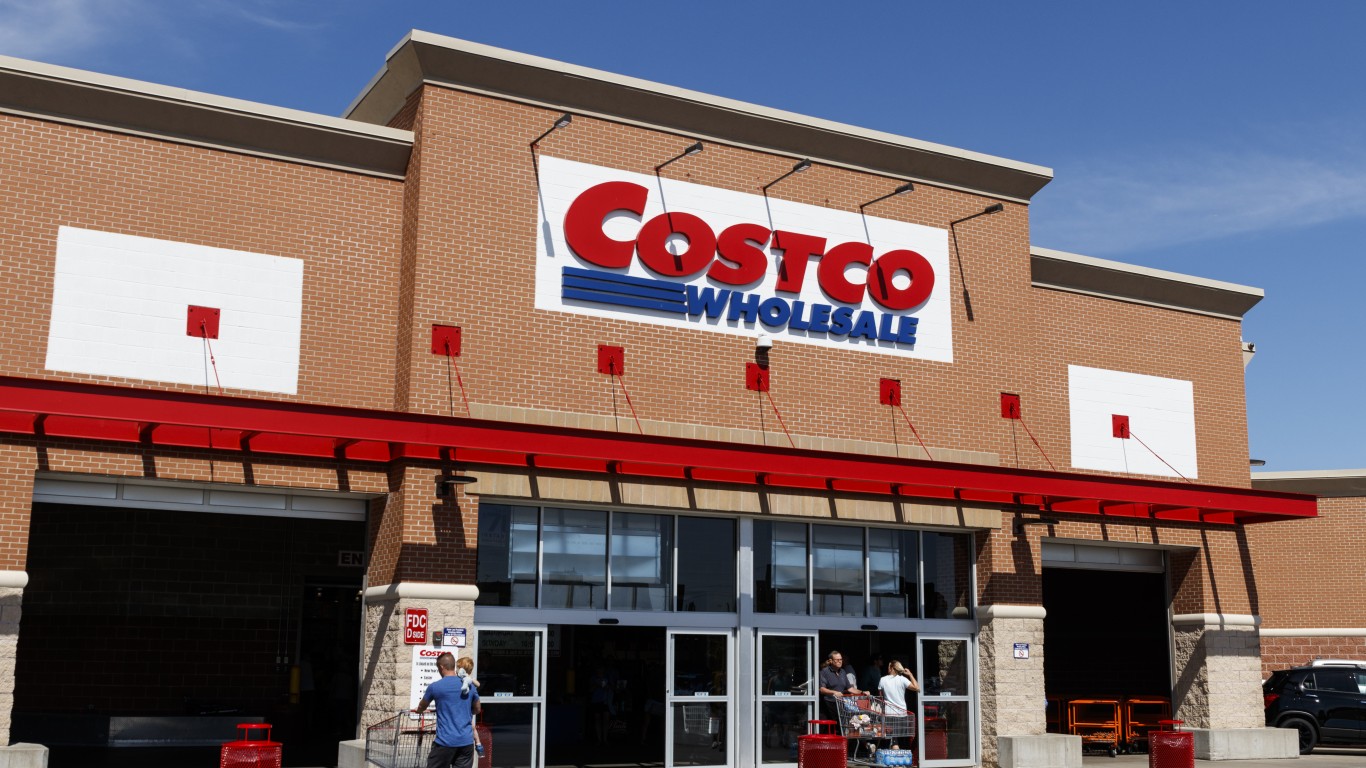In the past 10 years, some of America’s biggest food chains have lost more than 50% of their sales as they closed hundreds of locations nationwide. Source: Thinkstock
Source: Thinkstock
These restaurants, which include former American staples such as Big Boy, Ponderosa and Bennigan’s have not been able to maintain a steady crowd. They have failed to update their brand or menu options. As a result locations have been closed in favor of a new generation of eateries. Based on data provided by food industry consulting and research firm Technomic Inc., 24/7 Wall St. reviewed the 10 large restaurant chains with the biggest decline in locations and sales between 2001 and 2011.
Click here to see America’s Disappearing Restaurant Chains
Restaurant brands are facing new challenges, Darren Tristano, Executive Vice President of Technomic, told 24/7 Wall St. in an interview. “What’s happening today is that the contemporization of restaurants is creating a new breed, a new generation of restaurant in a competitive environment.” The struggling brands, which “tend to be older in nature,” Tristano said “have not kept up with current generations, or have been dominated by new competition within the segment.”
The type of cuisine these restaurants offer has also played a major role in their decline. In the case of barbecue establishments such as Damon’s and Tony Roma’s, competition isn’t the problem. Rather, the barbecue segment as a whole is performing poorly because its a necessarily limited cuisine. Tristano explained that this is in large part due to the fact that barbecue typically tends to attract male customers more than women. It also isn’t a meal diners tend to eat every day. Tony Roma’s sales declined by more than 70% between 2001 and 2011, while Damon’s sales fell by more than 75%.
Other chains are in segments that are doing fine, but the restaurant is losing out to newer chains with exciting brands and new offerings. TCBY, the frozen yogurt chain that experienced meteoric growth starting in the 1980s, has been cooling off for years. Traditional ice cream chains such as Coldstone Creamery have eaten into its sales, as have new frozen yogurt establishments such as Pinkberry. In 2001, there were 1,777 TCBY locations across the country. By 2011, there were just 405.
Many of the restaurants on our list saw their heyday come and go several decades ago. Of the 10 chains with the biggest declines, eight have filed for bankruptcy in the past decade. In some cases, hundreds of locations were closed overnight. The chains were either then purchased or resumed operations only once the company emerged from bankruptcy. The remaining franchises continued to operate. But reinvigorating these brands will be an uphill battle.
The recent economic recession has further made the recovery of these brands challenging. While it is clear that actively pressing into new markets is necessary to keep these restaurants growing, these chains have been forced to devote most of their resources just to remaining afloat. Tristano explained, “The economy’s been a big negative for these restaurants trying to gain traction or even grow, and so in many cases they’ve actually just continued to struggle and close units that were underperforming.”
Based on sales data provided by Technomic, 24/7 Wall St. reviewed the 10 restaurant chains that had 60% or greater declines in the number of actual store locations operating from 2001 to 2011. In order to identify the chains that were once the biggest, restaurants had to have sales of at least $225 million in 2001 and experience 50% or greater declines in sales over the same period.
10. Blimpie Subs & Salads
> Pct. of stores closed: 60.1%
> Total stores: 739
> Stores closed: 1,114
> 2011 sales: $115.3 million
> Pct. decline in sales: -60.4%
Blimpie first opened in Hoboken, New Jersey, in 1964 as the nation’s first sub-sandwich chain. Although it remains the nation’s third largest such chain, Blimpie has struggled over the last decade. In 2011, Blimpie had just 739 stores and $115 million in sales, down from 1,853 stores and nearly $300 million in sales in 2001. Blimpie was purchased by Kahala, a franchising company that also bought Cold Stone Creamery in 2007.
9. Ponderosa/Bonanza:
> Pct. of stores closed: 63.5%
> Total stores: 175
> Stores closed: 305
> 2011 sales: $241 million
> Pct. decline in sales: -61.7%
Ponderosa and Bonanza are steakhouses that offer “the spirit of the Old West … and honest-to-goodness value.” Like many casual dining franchises, the recession hurt steakhouses’ bottom line. In 2008, the parent company, Metromedia Steakhouses Co., filed for bankruptcy. Although the company, now called Homestyle Dining LLC, exited bankruptcy in October 2009, its steakhouses have largely disappeared. Between 2001 and 2011 the number of Ponderosa and Bonanza restaurants fell by nearly two-thirds.
Also Read: The Cities Where Everyone Has a Job
8. Big Boy
> Pct. of stores closed: 65.4%
> Total stores: 140
> Stores closed: 265
> 2011 sales: $183.4 million
> Pct. decline in sales: -68.4%
Big Boy, known for its double-decker hamburger and overall-wearing mascot, was opened in Glendale, California, in 1936. The company has struggled since its former franchiser, the Elias Brothers Corp., filed for bankruptcy in 2000. The year after the bankruptcy, there were 405 Big Boy restaurants nationwide. By 2011, there were just 140 restaurants in the U.S. In that time, annual sales at the chain have fallen by almost $400 million, from $580 million in 2001.
7. Don Pablo’s
> Pct. of stores closed: 71.0%
> Total stores: 38
> Stores closed: 93
> 2011 sales: $81.6 million
> Pct. decline in sales: -69.6%
Don Pablo’s describes itself as “Big Tex Bold Mex.” Avado Brands, the company that owned Don Pablo’s, went bankrupt twice in the last 10 years, first in 2004 and again in 2007. In 2008, the chain was sold to a restaurant group started by Avado’s bankruptcy lender. According to Tristano, full-service Mexican restaurants like Don Pablo’s have struggled as fast-casual restaurants such as Chipotle Mexican Grill (NYSE: CMG), have become America’s preferred choice for Mexican cuisine.
6. Tony Roma’s
> Pct. of stores closed: 71.6%
> Total stores: 46
> Stores closed: 116
> 2011 sales: $93 million
> Pct. decline in sales: -70.8%
Tony Roma’s was founded in 1972 and claims to be “the largest casual theme restaurant chain specializing in ribs in the world.” Between 2001 and 2011, Tony Roma’s domestic sales fell by over 70%, while its total number of U.S. restaurants declined from 162 to 46. The chain is struggling partly because, says Tristano, “barbecue is not an everyday food,” and because the cuisine tends to appeal only to males. In 2005, the restaurant’s parent company, Romacorp Inc., filed for bankruptcy. Although it is disappearing from the United States, Tony Roma’s is still active internationally with restaurants in over 30 countries.
5. TCBY
> Pct. of stores closed: 77.2%
> Total stores: 405
> Stores closed: 1,372
> 2011 sales: $98 million
> Pct. decline in sales: -60.4%
TCBY started in 1981 in Arkansas as “the country’s first frozen yogurt shop.” The chain was purchased by Mrs. Fields Holdings in 2000. At the time, the Chicago Tribune noted that “both TCBY and Mrs. Fields have considerable [brand] equity among consumers,” and that “in the still-escalating fast-service wars, it makes sense for operators to offer more than one product in order to create more traffic.” Despite this optimism, the combined company filed for bankruptcy protection in 2008, and again required a restructuring deal to avoid bankruptcy last year. Between 2001 to 2011, TCBY shut well over 1,300 stores, leaving just 405 locations as of 2011.
Also Read: Nine Beers Americans No Longer Drink
4. Damon’s Grill & Sports Bar
> Pct. of stores closed: 78.1%
> Total stores: 30
> Stores closed: 107
> 2011 sales: $70 million
> Pct. decline in sales: -75.4%
Damon’s was founded in 1979 and is currently based in Columbus, Ohio. It “is a leading full-service, casual dining restaurant concept” with locations in the Midwest and Southeast United States, as well as in the United Kingdom. The chain, which is part of the struggling full-service barbecue restaurant segment, filed for bankruptcy in 2009. According to Tristano, other restaurants have increasingly offered much of the food found on a Damon’s menu. As of 2011, Damon’s had just $70 million in sales, down more than 75% from 2001 when it had nearly $285 million in sales.
3. Country Kitchen
> Pct. of stores closed: 79.1%
> Total stores: 52
> Stores closed: 197
> 2011 sales: $44 million
> Pct. decline in sales: -82.4%
Country Kitchen was started in 1939 as a hamburger stand in Cincinnati, Ohio, and has been a national chain since 1958. Currently, however, it is concentrated in the Midwest and Plains states. In recent years, the chain has struggled to continue attracting customers. According to Technomic’s Tristano, the restaurant exists in the highly competitive mid-scale family style market, which has been crowded out by fast-casual dining. Between 2001 and 2011, Country Kitchen closed almost 200 locations, with the total number of restaurants falling from 249 to 52, as sales declined by more than 80% during the same period.
2. Ground Round Grill & Bar
> Pct. of stores closed: 80.9%
> Total stores: 25
> Stores closed: 106
> 2011 sales: $37.5 million
> Pct. decline in sales: -83.4%
Ground Round is a family style dining chain, founded in 1969 to provide a “‘neighborhood pub’ experience where everyone, including couples and families, felt comfortable.” Like a number of other chains on this list, Ground Round declared bankruptcy relatively recently. However, unlike other disappearing restaurants, after its bankruptcy in 2004, the chain was bought by its former franchisees. Despite the change in ownership, the chain has struggled to survive in recent years, maintaining just 25 restaurants in 2011.
1. Bennigan’s
> Pct. of stores closed: 88.2%
> Total stores: 33
> Stores closed: 247
> 2011 sales: $62 million
> Pct. decline in sales: -89.0%
In the past 10 years, no major restaurant has lost as much of its business as Bennigan’s. The Irish themed restaurant and bar’s parent company, Metromedia Restaurant Group, filed for bankruptcy in 2008. After declaring bankruptcy, Bennigan’s abruptly shut almost all of its franchises. As of last year, there were just 33 Bennigan’s restaurants and the chain’s sales for the year totaled just $62 million — more than half a billion dollars less than the chain’s 2001 sales. Despite these events, there is some hope for Bennigan’s — and perhaps some of the other chains on this list: a group of investors purchased the company and plans to open new locations. Technomic described one of the group’s new locations in Appleton, Wisconsin, as taking “all the best features of the casual dining restaurant today.”
Alexander E.M. Hess and Michael B. Sauter
Also Read: The Best and Worst Run States in America
Take This Retirement Quiz To Get Matched With An Advisor Now (Sponsored)
Are you ready for retirement? Planning for retirement can be overwhelming, that’s why it could be a good idea to speak to a fiduciary financial advisor about your goals today.
Start by taking this retirement quiz right here from SmartAsset that will match you with up to 3 financial advisors that serve your area and beyond in 5 minutes. Smart Asset is now matching over 50,000 people a month.
Click here now to get started.
Thank you for reading! Have some feedback for us?
Contact the 24/7 Wall St. editorial team.



